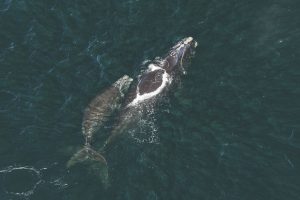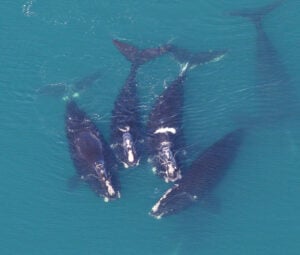
Wildlife
Punctuation’s mark: Can we save the critically endangered North Atlantic right whale?
After a series of mass deaths in recent years, what can we do?
- 4110 words
- 17 minutes
Wildlife

In the last three years, more than 30 right whales have been killed by ships or fishing gear entanglements — and at least 20 of those deaths were in Canadian waters.
Now there are less than 250 mature right whales, with less than 200 more adolescents, in the world.
These startling numbers have caused the International Union for Conservation of Nature to move the whales from “endangered” to “critically endangered” on its red list of global species under threat.
The next step on the list is extinction.
At the end of June, the Marine Animal Response Society and the Canadian Wildlife Health Cooperative released the final report detailing the right whale mass mortality event that occurred in Atlantic Canada in 2019. The push for necropsies to discover the cause of the whale deaths came after a similar mortality event in 2017 when 12 whales died unexpectedly. The report also includes a review of surveillance and mitigation efforts when it comes to right whales in Canadian waters to prevent mass mortality events from happening again.
“The report makes it clear that the whales are dying from human activities,” says Nick Hawkins, a conservation photographer who, due to COVID-19, is one of the only people conducting work on right whales in Canadian waters right now. “This is not news to anyone engaged in the right whale story, but does reinforce the urgent need to find solutions and enact strong conservation measures to reduce ship strikes and entanglements in fishing gear.”
For the last four years, Transport Canada has implemented a seasonal mandatory speed restriction of 10 knots across most of the Gulf of St. Lawrence. The same speed restriction is also imposed on the active shipping lanes when a right whale is spotted in the area.
For 2020, a 10 knot speed limit was also in place in parts of Cabot Strait in the spring and will be again in the fall, when right whales are migrating through the area.
“As storytellers, our primary goal is to bring these animals to a global audience,” says Hawkins about his usual work. “There exists surprisingly little high quality media of North Atlantic right whales, which is a major barrier to educating and engaging the public in their conservation. From aboard my vessel M.V. Calanus, my team is using the latest in stabilized camera technology to capture these animals as never before and build an archive of material that will represent North Atlantic right whales in popular media for decades to come.”
When COVID-19 hit, Hawkins and his team stepped into the role of data collectors. He calls it a “unique blend” of community science and storytelling, uploading data to an interactive WhaleMap online.
“Photographs of the whales paired with a GPS position can provide critical information to researchers, including which whales are showing up in the Gulf of Saint Lawrence, how they are using the habitat and the health of individual whales, especially those recovering from ship strikes and entanglements,” says Hawkins.
Environmental groups have been speaking out for years about missing pieces in right whale protection measures.
“The success of these measures depends on surveillance,” Oceana Canada campaign director Kim Elmslie previously told Canadian Geographic. “Fishing zone closures and speed requirements for vessels are triggered based on whale sightings, so we strongly urge the government to step up surveillance.”
Hawkins, whose work will feature in the November/December 2020 Canadian Geographic issue in a story by Alanna Mitchell on right whales, agrees there’s more to be done.
“Right whales are still dying at a rate far too high — and we are running out of time,” says Hawkins. “We need ambitious targets to reduce human impacts and an action plan that places obligations on the government to immediately prevent further deaths.”
Are you passionate about Canadian geography?
You can support Canadian Geographic in 3 ways:

Wildlife
After a series of mass deaths in recent years, what can we do?

People & Culture
In this essay, noted geologist and geophysicist Fred Roots explores the significance of the symbolic point at the top of the world. He submitted it to Canadian Geographic just before his death in October 2016 at age 93.

Kids
The massive North Atlantic Right Whale is Canada's “true whale of the ice.” …

Environment
The planet is in the midst of drastic biodiversity loss that some experts think may be the next great species die-off. How did we get here and what can be done about it?